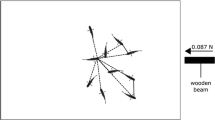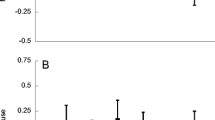Abstract
Recent studies have documented that exposure to high levels of background risk can induce neophobic predator avoidance in prey animals, whereby they respond to any novel cue with an anti-predator response. Such phenotypically plastic predator avoidance may allow prey to maximize anti-predator benefits in variable risk environments. It remains poorly understood whether risk assessment information from different sensory modalities can be integrated to induce generalized, cross-sensory system neophobic responses. Here, we directly test this hypothesis by exposing juvenile convict cichlids (Amatitlania nigrofasciata) to high- versus low-risk environments using either conspecific alarm cue (chemosensory risk) or a model avian predator (visual/mechanical risk) and testing their response to a novel chemosensory cue (Experiment 1) or visual cue (Experiment 2). Our results suggest that regardless of the sensory modality used to increased perceived risk, cichlids pre-exposed to high-risk conditions exhibited increased predator avoidance in response to any novel visual or chemical cue. As expected, cichlids pre-exposed to low-risk conditions did not display any neophobic responses. Our results suggest that induced neophobia is not cue specific; rather, it may function as a generalized response to perceived predation risk.



Similar content being viewed by others
References
Allouche S, Gaudin P (2001) Effects of avian predation threat, water flow and cover on growth and habitat use by chub, Leuciscus cephalus, in an experimental stream. Oikos 94:481–4920
Amo L, López P, Martín J (2004) Wall lizards combine chemical and visual cues of ambush snake predators to avoid overestimating risk inside refuges. Anim Behav 67:647–653. doi:10.1016/j.anbehav.2003.08.005
Botham MS, Kerfoot CH, Louca V, Krause J (2006) The effects of different predator species on antipredator behavior in the Trinidadian guppy, Poecilia reticulata. Naturwissenschaften 93:431–439. doi:10.1007/s00114-006-0131-0
Brown GE, Bongiorno T, Dicapua DM, Ivan LI, Roh E (2006) Effects of group size on the threat-sensitive response to varying concentrations of chemical alarm cues by juvenile convict cichlids. Can J Zool 84:1–8. doi:10.1139/Z05-166
Brown GE, Ferrari MCO, Chivers DP (2011) Learning about danger: chemical alarm cues and threat-sensitive assessment of predation risk by fishes. In: Brown C, Laland K, Krause J (eds) Fish cognition and behaviour, 2nd edn. Wiley-Blackwell, Chichester, pp 59–80
Brown GE, Ferrari MCO, Elvidge CK, Ramnarine I, Chivers DP (2013) Phenotypically-plastic neophobia: a response to variable predation risk. Proc R Soc Lond B 280:20122712. doi:10.1098/rspb.2012.2712
Brown GE, Elvidge CK, Ramnarine I, Chivers DP, Ferrari MCO (2014a) Personality and the response to predation risk: effects of information quantity and quality. Anim Cogn 17:1063–1069. doi:10.1007/s10071-014-0738-z
Brown GE, Ferrari MCO, Elvidge CK, Jackson CD, Chivers DP (2014b) Background level of risk determines the intensity of predator neophobia in cichlids. Behav Ecol Sociobiol 68:127–133. doi:10.1007/s00265-013-1629-z
Brown GE, Elvidge CK, Ramnarine I, Ferrari MCO, Chivers DP (2015) Background risk and recent experience influence retention of neophobic responses to predators. Behav Ecol Sociobiol 69:737–745. doi:10.1007/s00265-015-1888-y
Chivers DP, McCormick MI, Mitchell MD, Ramasamy RA, Ferrari MCO (2014) Background level of risk determines how prey categorize predators and non-predators. Proc R Soc Lond B 281:20140355. doi:10.1098/rspb.2014.0355
Dall SRX, Giraldeau L-A, Olsson O, McNamara JM, Stephens DW (2005) Information and its use by animals in evolutionary ecology. Trends Ecol Evol 20:187–193. doi:10.1016/j.treee.2005.01.010
Elmasri OL, Moreno MS, Neumann CA, Blumstein DT (2012) Response of brown anoles Anolis sagrei to multimodal signals from a native and novel predator. Curr Zool 58:791–796. doi:10.1093/czoolo/58.6.791
Elson PF (1962) Predator-prey relationships between fish-eating birds and Atlantic salmon. Fish Res Board Can Bull 133:1–87
Elvidge CK, MacNaughton CJ, Brown GE (2013) Sensory complementation and antipredator behaivoural compensation in acid-impacted juvenile Atlantic salmon. Oecologia 172:69–78. doi:10.1007/s00442-012-2478-6
Ferrari MCO (2014) Short-term environmental variation in predation risk leads to differential performance in predation-related cognitive function. Anim Behav 95:9–14. doi:10.1016/j.anbehav.2014.06.001
Ferrari MCO, Gonzalo A, Messier F, Chivers DP (2007) Generalization of learned predator recognition: an experimental test and framework for future studies. Proc R Soc Lond B 274:1853–1859. doi:10.1098/rspb.2015.2197
Ferrari MCO, Rive AC, MacNaughton CJ, Brown GE, Chivers DP (2008a) Fixed vs. random temporal predictability of predation risk: an extension of the risk allocation hypothesis. Ethology 114:238–244. doi:10.1111/j.1439-0310.2007.01468.x
Ferrari MCO, Vavrek MA, Elvidge CK, Fridman B, Chivers DP, Brown GE (2008b) Sensory complementation and the acquisition of predator recognition by salmonid fishes. Behav Ecol Sociobiol 63:113–121. doi:10.1007/s00265-008-0641-1
Ferrari MCO, Sih A, Chivers DP (2009) The paradox of risk allocation: a review and prospectus. Anim Behav 78:579–585. doi:10.1016/j.anbehav.2009.05.034
Ferrari MCO, Crane AL, Brown GE, Chivers DP (2015a) Getting ready for invasions: can background level of risk predict the ability of naïve prey to survive novel predators? Sci Rep 5:8309. doi:10.1038/srep08309
Ferrari MCO, McCormick MI, Meekan MG, Chivers DP (2015b) Background level of risk and the survival of predator-naïve prey: can neophobia compensate for predator naivety in juvenile coral reef fishes? Proc Roy Soc Lond B 282:20142197
Foam PE, Harvey MC, Mirza RS, Brown GE (2005) Heads up: juvenile convict cichlids switch to threat-sensitive foraging tactics based on chemosensory information. Anim Behav 70:601–607. doi:10.1016/j.anbehav.2004.12.011
Goodale E, Beauchamp G, Magrath RD, Neih JC, Ruxton GD (2010) Interspecific information transfer influences animal community structure. Trends Ecol Evol 25:354–361. doi:10.1016/j.tree.2010.01.002
Grant JWA, Girard IL, Breau C, Weir LK (2002) Influence of food abundance on competitive aggression in juvenile convict cichlids. Anim Behav 63:323–330. doi:10.1006/j.anbe.2001.1891
Joyce BJ, Demers EEM, Chivers DP, Ferrari MCO, Brown GE (2016) Risk-induced neophobia is constrained by ontogeny in juvenile convict cichlids. Anim Behav 114:37–43. doi:10.1016/j.anbehav.2016.01.007
Kim J-W, Brown GE, Dolinsek IJ, Brodeur NN, Leduc AOHC, Grant JWA (2009) Combined effects of chemical and visual information in eliciting antipredator behaviour in juvenile Atlantic salmon, Salmo salar. J Fish Biol 74:1280–1290. doi:10.1111/j.1095-8649.2009.02199.x
Leduc AOHC, Kim J-W, MacNaughton CJ, Brown GE (2010) The sensory complement model helps predict diel alarm response patterns in juvenile Atlantic salmon (Salmo salar) under natural conditions. Can J Zool 88:398–403. doi:10.1139/Z10.016
Lima SL, Bednekoff PA (1999) Temporal variation in danger drives antipredator behavior: the predation risk allocation hypothesis. Am Nat 153:649–659
Meuthen D, Baldauf SA, Bakker TCM, Thuken T (2016) Predator-induced neophobia in juvenile cichlids. Oecologia 181:947–958. doi:10.1007/s00442-15-2478-0
Mikheev VN, Wanzenbock J, Pasternak AF (2006) Effects of predator-induced visual and olfactory cues on 0 + perch (Perca fluviatilis L.) foraging behaviour. Ecol Freshw Fish 15:111–117. doi:10.1111/j.1600-0633.2006.00140.x
Munoz NE, Blumstein DT (2012) Multisensory perception in uncertain environments. Behav Ecol 23:457–462
Schmidt KA, Dall SRX, van Gils JA (2010) The ecology of information: an overview on the ecological significance of making informed decisions. Oikos 119:304–316. doi:10.1111/j.1600-0706.2009.17573.x
Seppänen J-T, Forsman JT, Mönkkönen M, Thomson RL (2007) Social information use is a process across time, space, and ecology, reaching heterospecifics. Ecology 88:1622–1633
Sih A, Ziemba R, Harding KC (2000) New insights on how temporal variation in predation risk shapes prey behavior. Trends Ecol Evol 15:3–4
Stankowich T, Blumstein DT (2005) Fear in animals: a meta-analysis and review of risk assessment. Proc R Soc Lond B 272:2627–2634. doi:10.1098/rspb.2005.3251
Vavrek MA, Brown GE (2009) Threat-sensitive responses to disturbance cues in juvenile convict cichlids and rainbow trout. Ann Zool Fenn 46:171–180
Weissburg M, Smee DL, Ferner MC (2014) The sensory ecology of nonconsumptive predator effects. Am Nat 184:141–157. doi:10.1086/676644
Wisenden BD, Sargent RC (1997) Antipredator behavior and suppressed aggression by convict cichlids in response to injury-released chemical cues of conspecifics but not to those of an allopatric heterospecific. Ethology 103:282–291
Wisenden BD, Chivers DP, Smith RJF (1995) Early warning in the predation sequence—a disturbance pheromone in Iowa darters (Etheostoma exile). J Chem Ecol 21:1469–1480
Acknowledgments
We thank Ebony E. Demers, Laurence Feyten and Amanda Jeanson for assistance in the laboratory. All work reported herein was conducted in accordance with Concordia University Animal Research Ethics protocol # AREC-BROW-2011 and # 30000255. Financial support was provided by Concordia University and the Natural Sciences and Engineering Research Council of Canada (NSERC) to G.E.B. and the University of Saskatchewan and NSERC to D.P.C. and M.C.O.F.
Author information
Authors and Affiliations
Corresponding author
Ethics declarations
Conflict of interest
The authors declare no conflict of interests.
Rights and permissions
About this article
Cite this article
Brown, G.E., Jackson, C.D., Joyce, B.J. et al. Risk-induced neophobia: does sensory modality matter?. Anim Cogn 19, 1143–1150 (2016). https://doi.org/10.1007/s10071-016-1021-2
Received:
Revised:
Accepted:
Published:
Issue Date:
DOI: https://doi.org/10.1007/s10071-016-1021-2




